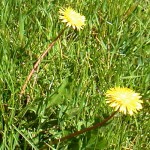by Catherine Haug
While it is true that one man’s flower is another man’s weed, or as another writer puts it, “A weed is just a plant growing where you don’t want it,” (1) it can be very frustrating when they take over your garden.
Here’s a great tip for minimizing weeds: using cover crops: (2)
“A quick annual such as buckwheat can be planted as a smother crop to prevent weeds from flourishing on bare soil. Cover crops also can be used for a longer period, or even a full season, to combat a weed problem.”
These fast-growing crops take over the soil and smother out the weeds. An added bonus of most cover crops is that they do double duty: not only do they suppress weeds, but also they are often an important food crop, and/or they enrich the soil as ‘green manure.’ For example:
- Buckwheat, not-really-a-grain, can be used like grains in many recipes (think buckwheat pancakes), especially important for gluten-free diets;
- Clover, a legume that adds important nitrogen to the soil;
- Soybeans, both a food crop and a legume;
- Field peas, a legume that produces sweet, tender tendrils for stir fry or salad mixes; and dried yellow peas that are great for soups (dal).
Want to know more about including cover crops in your garden plan, and the benefits they provide? Read on…
Cover crops for gardens
Cover crops are most often used on an agricultural (farm) scale, but they can also be used in gardens, big and small.
When I was a kid, my Dad decided to turn a portion of our yard into a garden. It had originally been a strawberry field, but had become overgrown with weeds. The soil was mostly clay and sand and was sadly in need of a make-over, so he tilled the field and planted it with clover. When it began to flower, he mowed it down before it went to seed, then tilled that under. By then, fall had arrived so he mulched the area heavily for the winter. The next spring, it was ready for planting, and the weeding was minimized as the garden grew through the summer.
Cover crops can be integrated into your overall garden plan: (4)
“After spring crops of lettuce, radishes, and other early vegetables have been harvested, plant a fast-growing cover crop, such as buckwheat. In most climates, you can allow this cover crop to flower and still have time to plant a crop of frost-tolerant vegetables. Cover crops can also be planted in the fall after some main season crops, such as cabbage, are finished.”
For detailed tips on Planting, Care and Killing cover crops, see Cover Crop Basics, from OrganicGardening.com.(4)
Benefits of cover crops for sustainable agriculture
The following benefits are from National Sustainable Agriculture Information Service article: Overview of Cover Crops and Green Manures (3):
- Adds organic matter and soil structure: “A well-aggregated soil tills easily, is well aerated, and has a high water infiltration rate. Increased levels of organic matter also influence soil humus.”
- Nitrogen production: Nitrogen is one of the essential nutrients in soil. “Nitrogen production from legumes is a key benefit of growing cover crops and green manures.
- Increase soil microbe activity, to optimize the health and nutrient value of the soil. “A rapid increase in soil microorganisms occurs after a young, relatively lush green manure crop is incorporated into the soil. The soil microbes multiply to attack the freshly incorporated plant material. During microbial breakdown, nutrients held within the plant tissues are released and made available to the following crop.”
- Nutrient enhancement: “cover crops help recycle other nutrients on the farm. Nitrogen (N), phosphorous (P), potassium (KB], calcium (Ca), magnesium (Mg), sulfur (S), and other nutrients are accumulated by cover crops during a growing season.”
- Weed suppression: “Cover crops take up space and light, thereby shading the soil and reducing the opportunity for weeds to establish themselves.”
- Soil and water conservation: “The soil conservation benefits provided by a cover crop extend beyond protection of bare soil during non-crop periods. The mulch that results from a chemically or mechanically killed cover crop in no-till plantings increases water infiltration and reduces water evaporation from the soil surface. Soil cover reduces soil crusting and subsequent surface water runoff during rainy periods.”
Sources
- Planet Natural
- Johnny’s Selected Seeds: Smother Crops/Weed Suppression
- ATTRA: Fundamentals of Sustainable Agriculture: Overview of Cover Crops & Green Manures
- Organic Gardening: Cover Crop Basics
